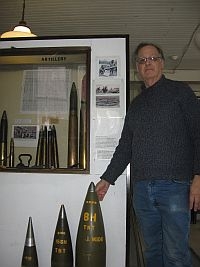 (Host) Bruce Bird has been collecting war memorabilia for more than 50 years. What he can’t reasonably keep around the house – like a submarine or a tank – he’s made models for.
(Host) Bruce Bird has been collecting war memorabilia for more than 50 years. What he can’t reasonably keep around the house – like a submarine or a tank – he’s made models for.
At an old schoolhouse in Pownal, Bird has turned his all-consuming hobby into a museum, and a lesson about one unique aspect of World War II history.
VPR’s Steve Zind reports.
(Bird) "This is a general case. It’s basically tanks and ammunition….
(Zind) Bruce Bird loves guns and ammo; especially the old war variety. The glass display cases spread through two rooms of this old schoolhouse are full of bullets and artillery shells of all sizes, along with models of bigger artillery guns and tanks. Bird says the collection represents fifty years of fascination with anything that goes bang.
What makes this more than an oversized hobby is the fact that Bird is trying to tell a story here. A look at the old photos on the walls makes it clear: the soldiers in the photos – men and women – are African American. Bird, who is the founder, curator and sole employee of the Museum of Black World War II History, is not.
(Bird) "It technically should be run by a rich, famous black veteran. As you can see, I’m none of the above.
(Zind) For most of his life Bird had no idea that African Americans served in World War II. He credits Venus Williams, of all people, for sparking his interest in the subject.
(Bird) "Because I was watching her play tennis one time and I said, ‘I wonder if she had any relatives in World War II.’ That sort of put everything together!"
(Zind) To put everything together, Bird retired from his job and sold his house. The money went into creating a museum space in the schoolhouse he rents from the city. He lives upstairs. You won’t find the trappings of a modern museum here – like audio visual displays and interactive features, but there’s a poignancy to the old black and white photos and the descriptions taped in the display cases. Bird has become an expert on African-Americans in the Second World War. He says when the war began, much of the armed services was whites-only.
(Bird) "You couldn’t do anything in the Navy but very restricted work. You couldn’t be in the Marines at all. You couldn’t be in the Air Force at all."
(Zind) That all changed, Bird says, because so many soldiers were needed for the war effort and also because attitudes about race were slowly evolving. For black women the barriers were even higher.
(Bird) "This is the women’s case. They not only had to deal with racism, they had to deal with sexism also. There were 7,093 women in the assorted services."
(Zind) Bird has stories to go along with every photo in the Museum of Black World War II History: About the black combat units who were used to play the part of the enemy in training in Texas. They were so well trained that by the time they were sent overseas to fight they excelled. Then there are stories of the famed Tuskegee Airmen – a unit of highly decorated fighter pilots. And Bird will tell you about the artillery men who fought in Belgium at the siege of Bastogne.
(Bird) "When Bastogne was surrounded during the Battle of the Bulge, half of the artillery battalions were black. You didn’t see one black artillaryman in the movie ‘The Battle of the Bulge."
(Zind) Bird says someone, needs to tell the stories of the 1.1 million African-Americans who served in the military in World War II. He says in the nearly four years the museum has been open, he’s also learned a lot from visitors.
(Bird) "The thing I like about the museum is I get all sorts of people who come in here, and my visitorship is between 30 and 40 percent black, who tell me all sorts of interesting stories and pay me to listen. So I’m having a ball."
(Zind) Incidentally, Bird never did find out if Venus Williams had relatives who served in the war.
For VPR news, I’m Steve Zind.
Note: The Museum of Black World War II History is open weekends for the winter. You’ll find a link to the museum at our Website, VPR dot net. Just click on Vermont Edition.